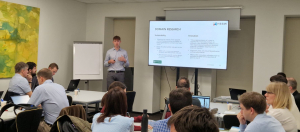LAURA CASTRO
XYZ Specialist
Lorem ipsum dolor sit amet, consectetuer adipiscing elit, sed diam nonummy nibh euismod tincidunt ut laoreet dolore magna aliquam erat volutpat. Ut wisi enim ad minim veniam, quis nostrud exerci tation
-
HOME
-
WORK
-
BATTERY TECHNOLOGIES
-
CIRCULAR ECONOMY
-
DIGITAL MANUFACTURING TOOLS
-
ELECTRIC DRIVES
-
HYDROGEN SYSTEMS
-
MANUFACTURING STRATEGY
-
MANUFACTURING ENGINEERING
-
SUPPLY CHAIN & LOGISTICS
-
LEAN MANUFACTURING & AUTOMATION
-
INSIGHTS
-
BLOGPOSTS
-
REPORTS
-
CASE STUDIES
-
COMPANY NEWS
-
EVENTS
-
TEAM
-
CAREERS
-
CONTACT
-
REQUEST A DEMO

CASE STUDIES
ReGaIL – Establishing a Novel Circular System for Allium Recovery
/0 Comments/in Uncategorized /by Emily Laver
A Key Element in the Future of Electrification
Gallium is expected to replace silicone in critical power system semiconductors in the near future due to its comparatively superior characteristics of a wider band gap, faster switches, lower heat loss, and smaller space requirements. Semiconductors are used in applications for power electronics, machines, and drives (PEMD). They are also a vital part of electric vehicles.
The UK, given a lack of natural gallium resources, currently relies on imports of gallium from abroad. To limit the financial costs and environmental footprint this causes, it is vital to identify ways of capturing maximum value from gallium through recovering and recycling.
The ReGaIL project was undertaken to explore whether it may be possible to recover gallium from end-of-life LED (light emitting diode) lamps. This would establish a never before explored method of recycling – currently, there is no company in the world that recycles gallium from end-of-life products.
A Robust Business Case
ReGaIL successfully culminated in June 2021. The project demonstrated new recovery methods using novel solutions – ionic liquids – instead of the more conventional aqueous chemistries, which are based on strong oxidants and concentrated acids. Ionic liquids provide an environmentally friendly way to recover gallium, which can then find a second-life in other applications, amongst them as a key part in semiconductors.
In the process, project partners discovered that not only gallium, but also other metals such as indium, silver, and gold, can be recovered from end-of-life LED lamps. This increases the business potential of recovering gallium. The current market price of gallium is £210 per kilogram, but this is expected to rise as gallium is increasing in popularity for PEMD applications. Recovering gallium as well as other metals from end-of-life LED lamps increases the profit margin significantly. Although an LED lamp holds a relatively small amount of gallium and other metals, the increasing value of these metals means that a solution that maximises volume while minimising costs could be quite profitable.
The ReGaIL project resulted in a business model and factory simulation of gallium recovery. This included a detailed analysis of the gallium recovery process, an assessment of the costs involved, and the drivers for profitability. More work needs to be done to quantify the profit margin exactly.
ReGaIL was a collaborative project led by S2S Electronics, with Envaqua, E.C. Williams, the Institute of Material Finishing (IMF), Recolight, and HSSMI. It received funding from Innovate UK under the Driving the Electric Revolution (DER) Challenge.
CONTACT US
Contact us today for a short initial conversation on how HSSMI can help your organisation achieve its strategic goals.





















































































































































































